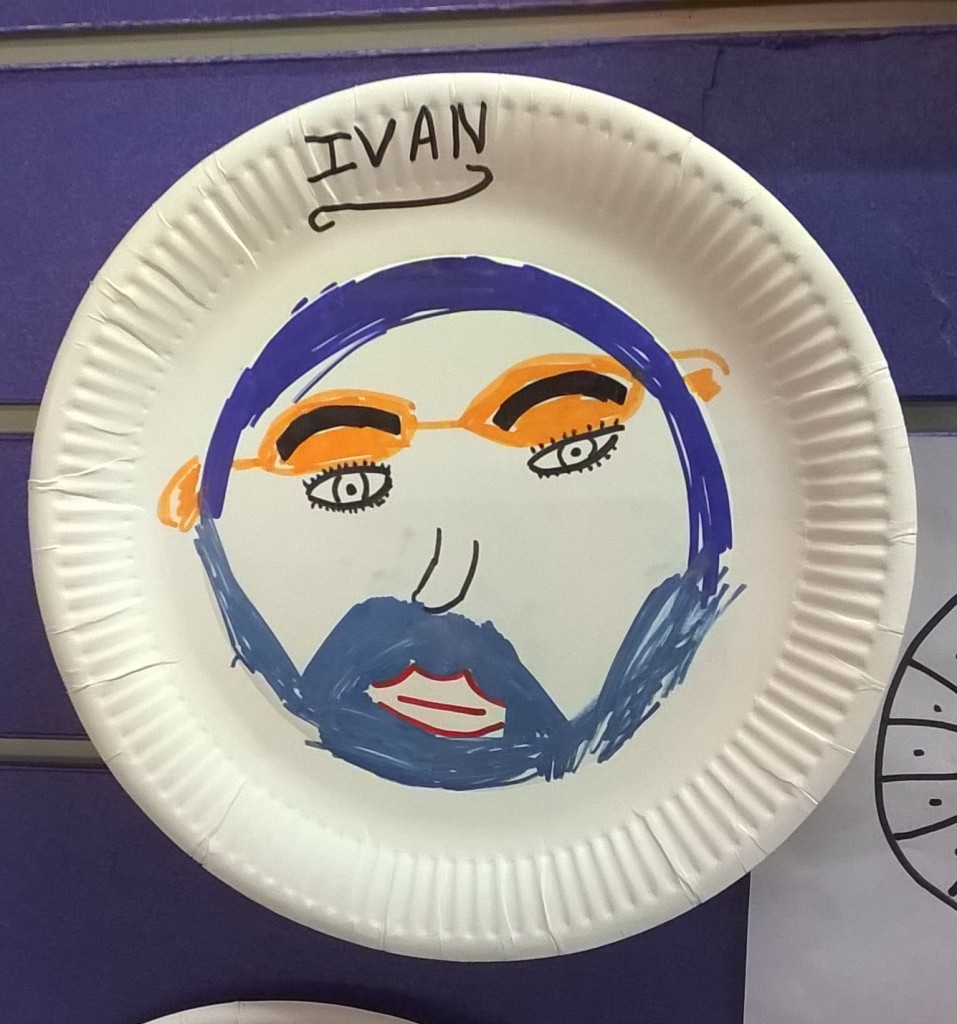Hello.
We've moved to a new site that includes a new blog and a new forum. Everyone can now take part freely and talk about socially engaged, ecologically engaged and participatory art!
Check us out at:
sociallyengagedart.net/engagedartnet/
Socially engaged & participatory arts network
A space for socially engaged and participatory artists, collectives and organisations. A commons where we can discuss our practice as a group - support each other, share experiences and opportunities, develop our practices together. We share a wish for our practice to be recognised as an unique, interdisciplinary and process-based art form. Beyond this, we often work in different ways and accept that we will not always agree on everything…
Tuesday, 13 October 2015
Monday, 27 July 2015
Validation beyond the gallery
When I became Executive Director of Axisweb in April 2015, I was acutely aware of a sea change within the cultural landscape. I am certainly not unique in this respect: Alistair Hudson (Director of MIMA) notes art and culture are under scrutiny as never before and the use value of art has slipped away from ordinary society. At the same time however, we see artists working with people and spaces, in collaborative, dynamic and interactive ways. Artists operating outside the gallery have come to play an essential role in society, yet these activities appear misunderstood, poorly profiled and simply not valued at the level of practice supported and promoted by the gallery sector.
At Axisweb we decided it was a good time to ask some questions. With the aim of better understanding the experiences of individuals working beyond the gallery, we commissioned a new piece of research with a focus on how validation and visibility are (or aren’t) being gained.
Written by Dr Amanda Ravetz and Dr Lucy Wright of Manchester School of Art, the research is a response to our questions and through a series of semi-structured interviews captures the opinions and experiences of producers, commissioners and artists all operating outside of galleries.
The report substantiates feelings that many artists will be familiar with: exclusion, rejection, misrepresentation [galleries use the wrong language], sidelining and being unrecognised, all for producing ‘the wrong kind of work’. These are issues which have been aired many times, however we are determined that this research will be a catalyst for change.
We have established working groups made up of artists, producers and commissioners to drive this process. These groups will develop collaborative mechanisms to tackle the issues raised in the research and consider and implement ways to improve advocacy and profiling work beyond the gallery. If you are interested in becoming part of this process, please get in touch.
By continuing our partnership with MMU and expanding this membership, we will explore and test new models focusing on use value, metrics and social signs that help champion, profile and evaluate artists and art beyond the gallery. Ultimately, we aim to connect and engage with a broader public to reinforce the value of art and artists within society.
An online presence for the campaign planned in the coming months will include opportunities for engagement, however in the meantime if you have any ideas or feedback you want to share please do get in touch (mark@axisweb.org)
Mark Smith, July 2015
At Axisweb we decided it was a good time to ask some questions. With the aim of better understanding the experiences of individuals working beyond the gallery, we commissioned a new piece of research with a focus on how validation and visibility are (or aren’t) being gained.
Written by Dr Amanda Ravetz and Dr Lucy Wright of Manchester School of Art, the research is a response to our questions and through a series of semi-structured interviews captures the opinions and experiences of producers, commissioners and artists all operating outside of galleries.
The report substantiates feelings that many artists will be familiar with: exclusion, rejection, misrepresentation [galleries use the wrong language], sidelining and being unrecognised, all for producing ‘the wrong kind of work’. These are issues which have been aired many times, however we are determined that this research will be a catalyst for change.
We have established working groups made up of artists, producers and commissioners to drive this process. These groups will develop collaborative mechanisms to tackle the issues raised in the research and consider and implement ways to improve advocacy and profiling work beyond the gallery. If you are interested in becoming part of this process, please get in touch.
By continuing our partnership with MMU and expanding this membership, we will explore and test new models focusing on use value, metrics and social signs that help champion, profile and evaluate artists and art beyond the gallery. Ultimately, we aim to connect and engage with a broader public to reinforce the value of art and artists within society.
An online presence for the campaign planned in the coming months will include opportunities for engagement, however in the meantime if you have any ideas or feedback you want to share please do get in touch (mark@axisweb.org)
Mark Smith, July 2015
Click on the publication to view the report, click 'Expand' to enlarge.
Wednesday, 8 July 2015
What is social practice? A short poem about one transitional definition by Stephen Pritchard
There's lots of discussion about how to define our field of practice. I'm not sure we can or even should? I'm very interested in the notion of transitional art practice. I was a bit unsure at first. I think I had problems fully comprehending the word when I was first introduced to it by Ruth Ben-Tovim. She was clear. I blocked it. I was all about "socially engaged". Perhaps I still am? Reading Playing for Time by Lucy Neal has made me rethink my practice and my research alot. Transitional art links back to my first encounters with the work of Suzi Gablik. Lucy's book and Ruth's passionate application of transitional art practice are beginning to reconnect me to Suzi's ideas about reenchantment. Perhaps I'm experiencing something of a transition?
This poem was a quick response to Cara Courage's call for practitioners to describe social practice. I re-read it as a transitional piece with key elements of transitional art vocabulary missing. I think I'm a little cold. Unempathic. More work to be done. Would love to hear your thoughts and criticisms. Perhaps you would like to share your own interpretations?
Anyway...
What is social practice?
Little creative acts of not knowing.
Political, sometimes radically activist, acts.
Potential spaces. Safe places where dangerous new
realities might grow. Grassroots. Social justice. Collective.
Autonomous. Communal.
Deeply suspicious of instrumentalism and state. Outside of institutions. Around and across margins.
A practice in which art as concept is everywhere.
Unspoken, like innumerable tiny little secrets shared in moments outside the false strictures of coordinated civic time.
Uncertain.
Always uncertain…
Messes of thread.
Stephen Pritchard.
Monday, 6 July 2015
SOME THOUGHTS ABOUT SOCIALLY ENGAGED ART BY THERESA EASTON, CHAIR OF ARTISTS' UNION ENGLAND
We are really pleased that Theresa Easton has joined our network as a member. Theresa does amazing work as chair of Artists' Union England - a union who welcome members who are socially engaged artists.
When Theresa joined us, she wrote a short statement about socially engaged art practice. She is happy that we share it here:
We welcome any comments, thoughts, responses.
When Theresa joined us, she wrote a short statement about socially engaged art practice. She is happy that we share it here:
We couldn't agree more. Tokenism in our field is dangerous and misleading.
I think our field of practice should have equal status with all art practices. I think arts organisations, public bodies and commercial businesses that appear to incorporate social engagement into their commission, project, residency etc need to fully understand the area of work and not use is as a token gesture and pay lip service to the fundamentals of the practice.
We welcome any comments, thoughts, responses.
LIST OF OUR MEMBERS - JULY 2015
We are an open network of members spanning artists, arts organisations, writers, academics. We have 23 members to date.
Anyone can join us free by clicking here.
We are:
Anyone can join us free by clicking here.
We are:
| Amy Hirst |
| Bridget McKenzie |
| Cara Courage |
| Carol Parker |
| Gabriela Silva |
| Genevieve Rudd |
| Hannah Marsden |
| Hayley Roberts |
| Jack Newsinger |
| Jean McEwan |
| Kate Pahl |
| Kerry Lanigan |
| Liz Postlethwaite |
| Lucy Neal |
| Lydia Catterall |
| Mark Smith (AxisWeb) |
| Pauline Taylor |
| Ruth Ben Tovim |
| Sian Rees |
| Stephen Pritchard |
| Susan Jones |
| Theresa Easton |
| Tracy Shaw (Loca Creatives) |
Wednesday, 3 June 2015
'Another great week in the Wur Bradford market stall' by Jean McEwan
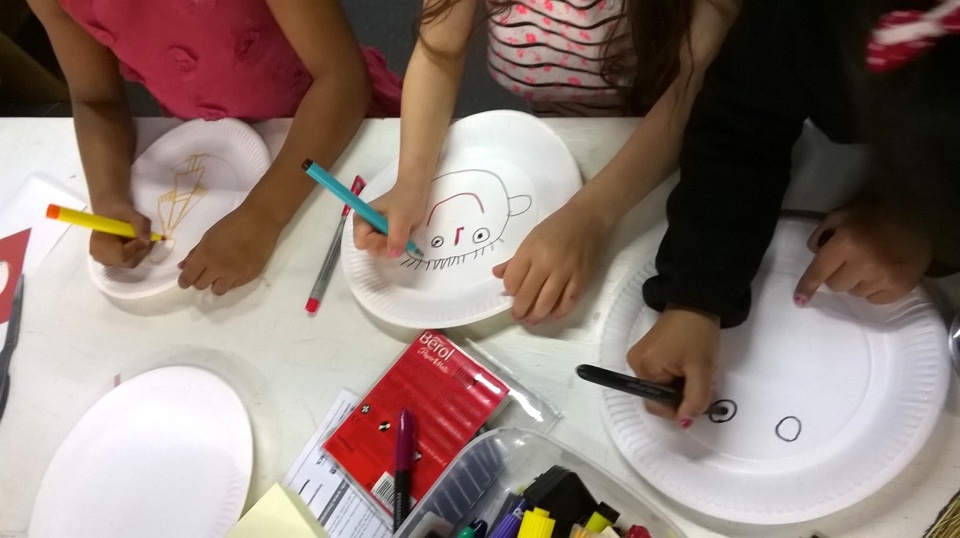
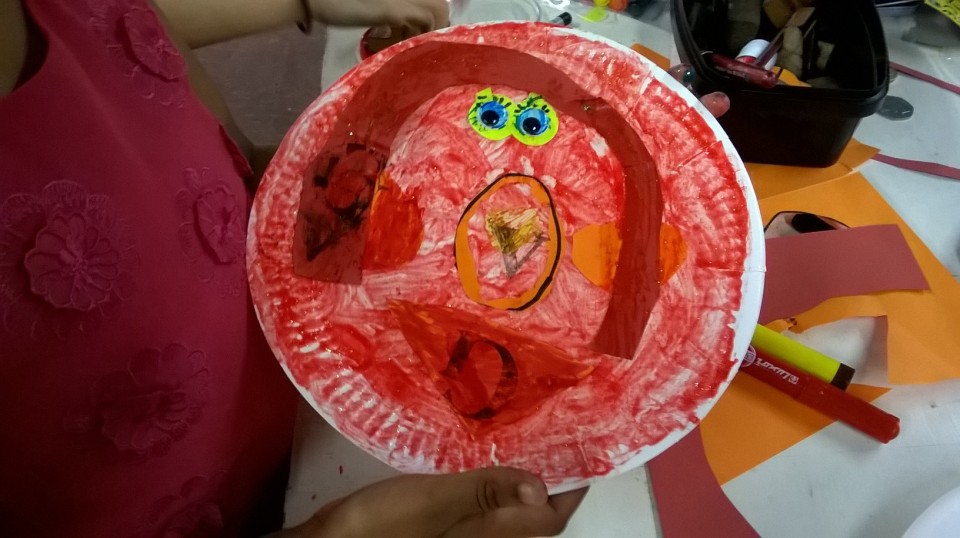
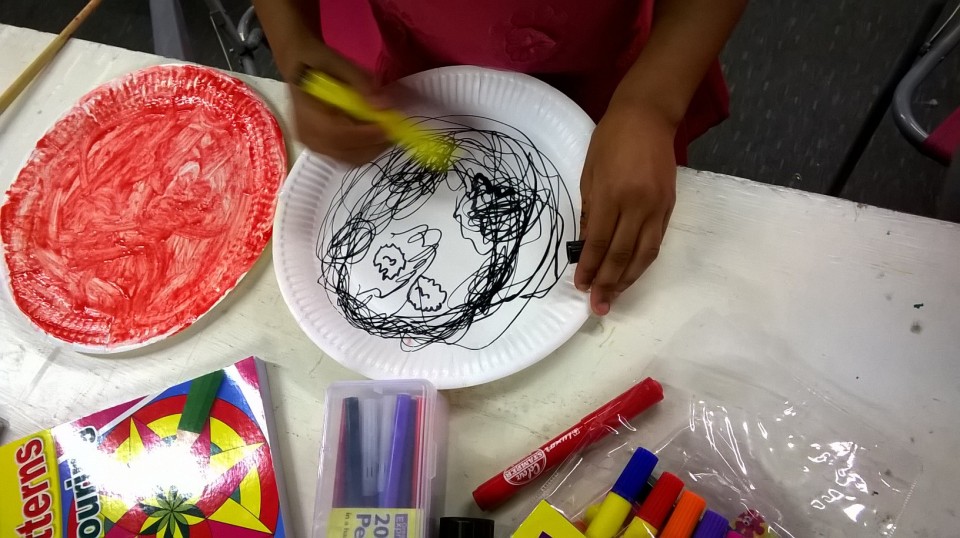
It’s been half term so I had lots of young visitors this week. Conchetta, Jessica, Rhadha, Dantrell, Harvey and Mohammed were among the kids who came in to get creative and kept me and other visitors entertained. Connie Jess and Rhadha all have parents who run stalls in the market, and they took me over to introduce me to them.

Dantrell was over visiting from Leeds, and he came into make some stuff while his mum was getting her hair done in one of the hairdressers in the market. He made this book and he also made some headphones from cardboard for a costume for his school assembly.
Ann Marie came by again this week with her husband Martin to bring some of her paintings and drawings to put up in the space, including these pieces
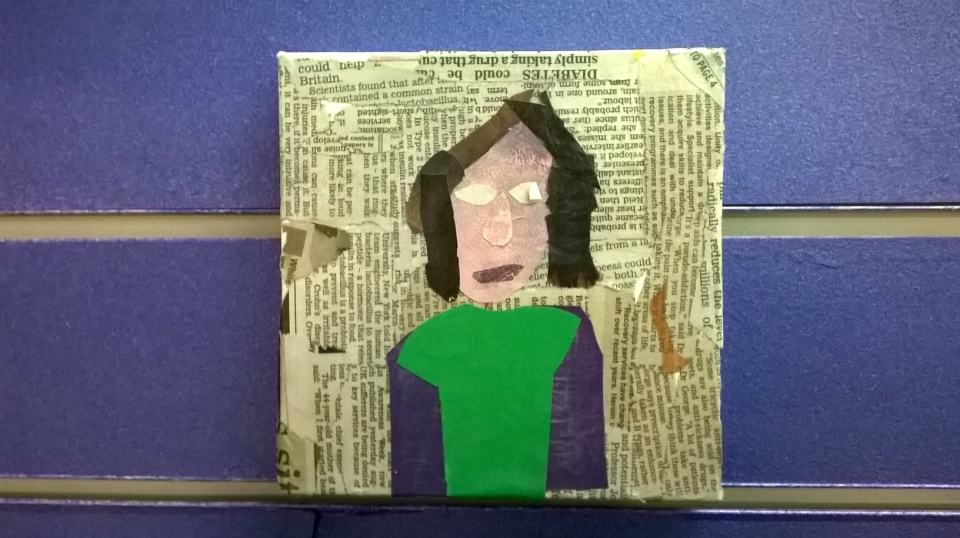
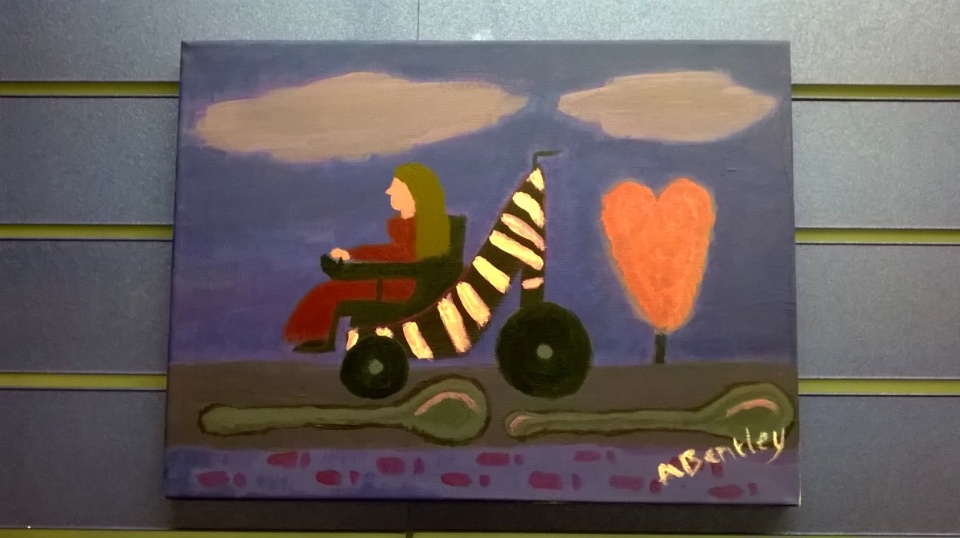
Ann Marie explained the personal significance of the symbols in the above painting, and how they relate to her disability and health. She was kind enough to type this out for me later and send them to me so I could share them here and print them out to put in the space. She says
“The symbols stand for : Highheel – feminism the love of heels I but cant wear them , the difficulty getting round. Stripes – Zebra logo for hypermobility syndromes and EDS (see link http://www.ehlers-danlos.org/about-eds-uk/why-the-zebra/) Purple sky – brain fog and fatigue, spoons- fatigue theory known as the spoon theory :http://www.butyoudontlooksick.com/category/the-spoon-theory/ and the footprints are about my feeling that i want people to understand to metaphorically walk with me rather than ahead and in a way walk with me instead of away as friends have in the past.”
The lovely market staff (thank you Kevin and Jimmy! ) are organising the making of a special ramp so Ann Marie can get proper access to the space in her wheelchair (there’s a 5 inch step) so next week she can come in and get more involved.
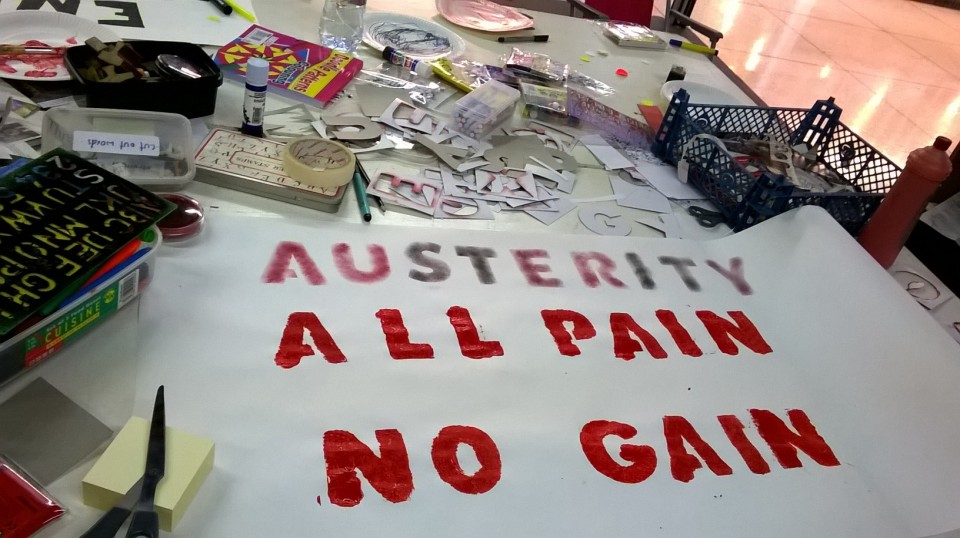
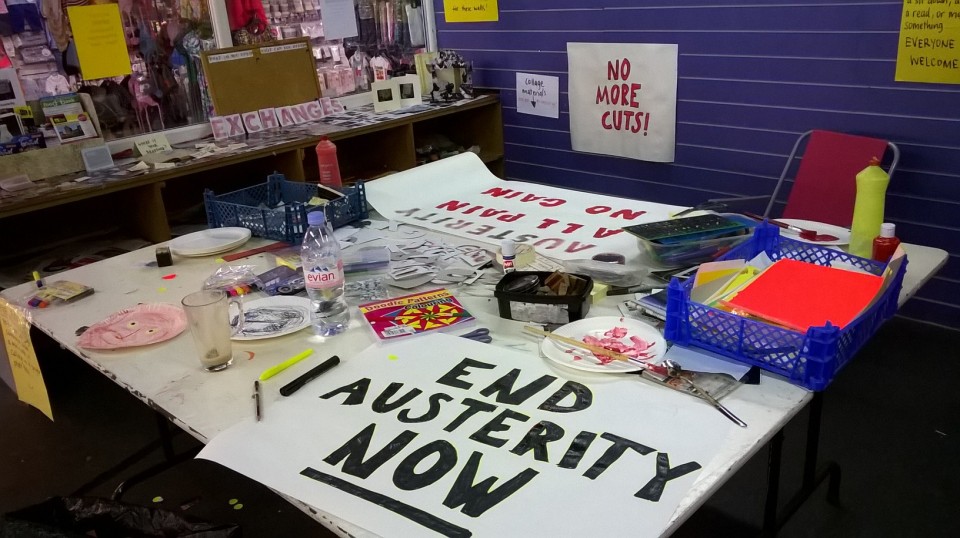
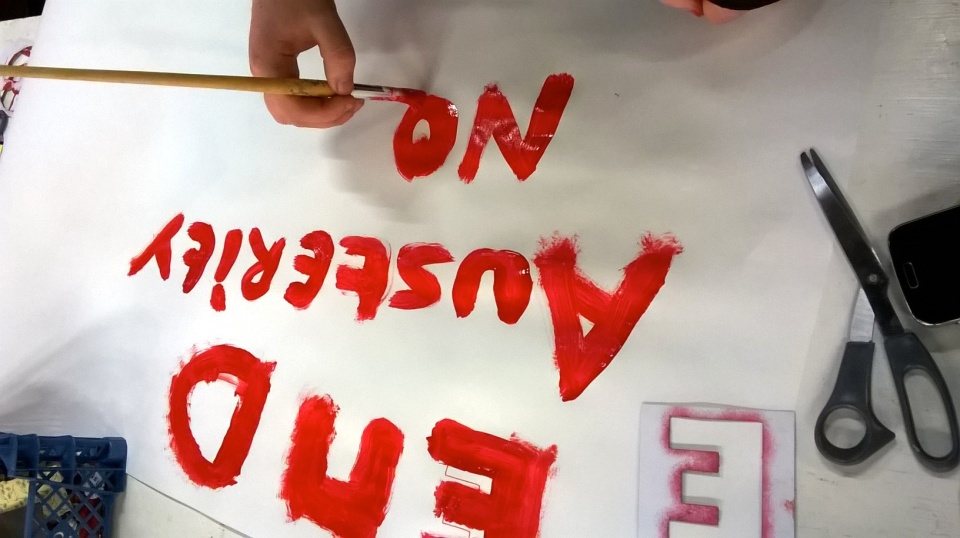
Matthew came down on Tuesday to help make some banners for the Anti Austerity Rally which happened on Wednesday in Centenary Square – and he also stayed around to make this instant book about the Bradford Bulls
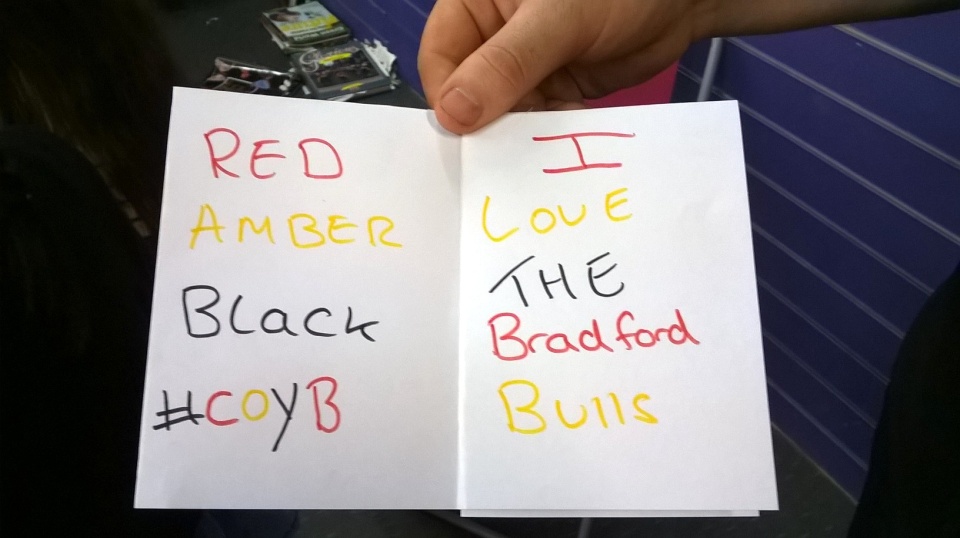
A couple more people from a local Women’s Refuge stopped by to say hi and check out what’s going on – they are going to tell the service users about the space and see if any of them wants to come down. Hope so!
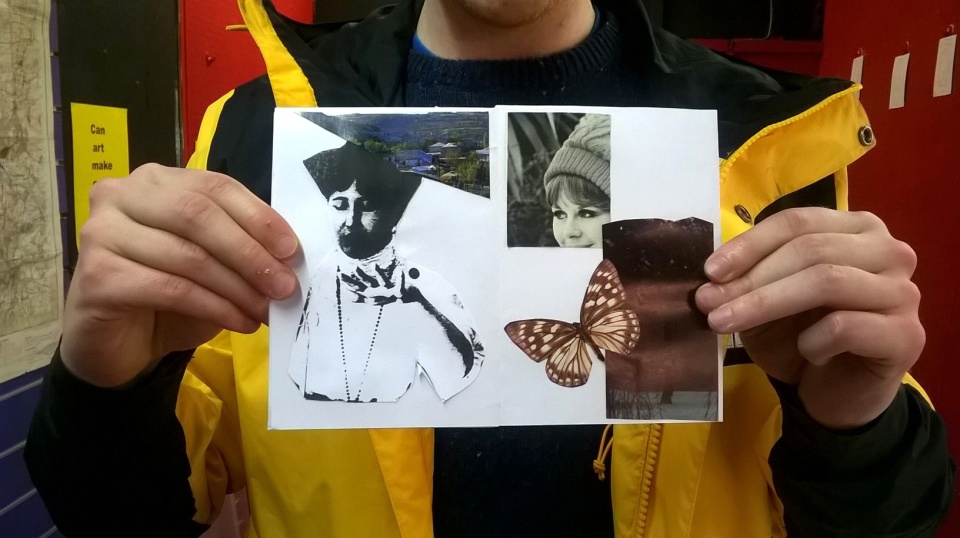
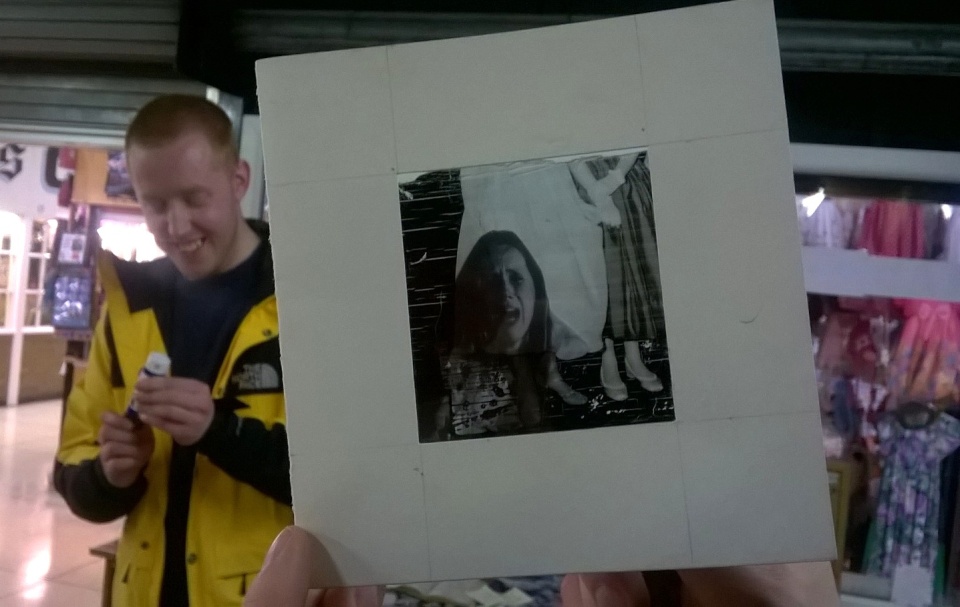
Ben had found out about the stall via Twitter and popped in a couple of time this week. He wrote some contributions to the affirmations area and also made a collaged instant book. He told me and Stuart, who was visiting at the same time, about some of the music he likes, and we chatted about allsorts.
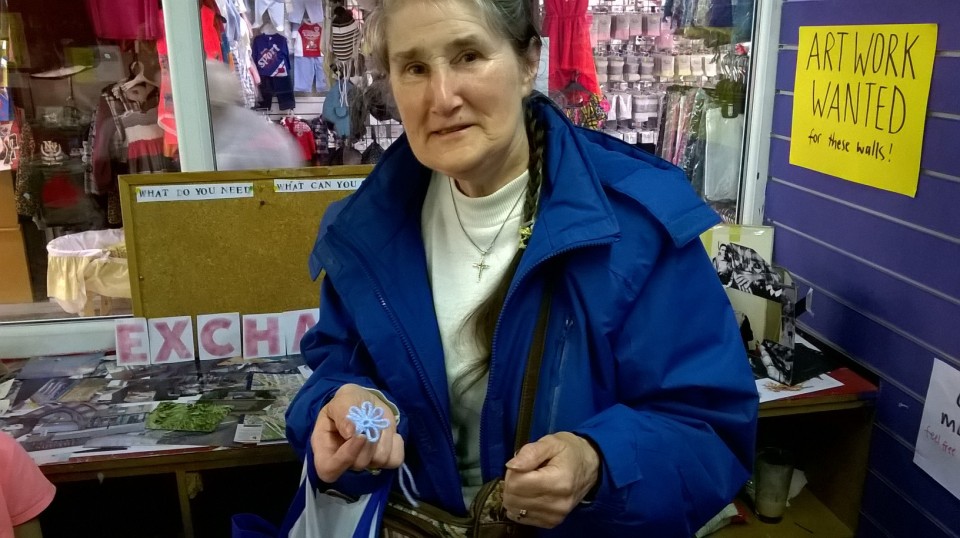
Margaret was born and brought up in Bradford, but moved to Lancashire some years ago. She was back for a visit for the day and was having a look round the market. She came in to chat and tell us some stories about Bradford as it used to be, and made me this lovely ‘tatting’ flower from wool she had in her bag. Thank you Margaret!
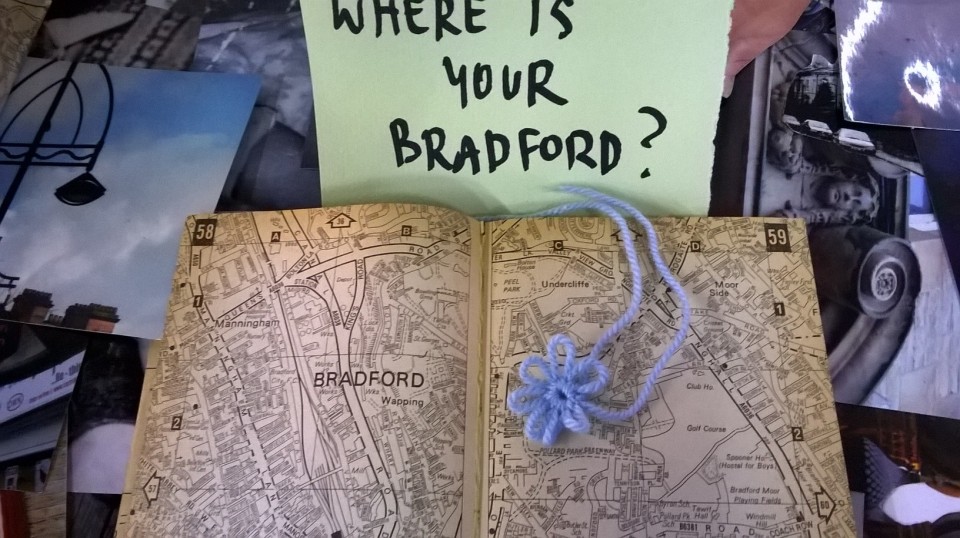
One of my favourite moments from this week was when Kyra, a young visitor who popped in with her two sisters Nieve and Kya, did this impromptu paper plate portrait of Ivan, who had popped in to visit. He is rightly chuffed to bits with it.
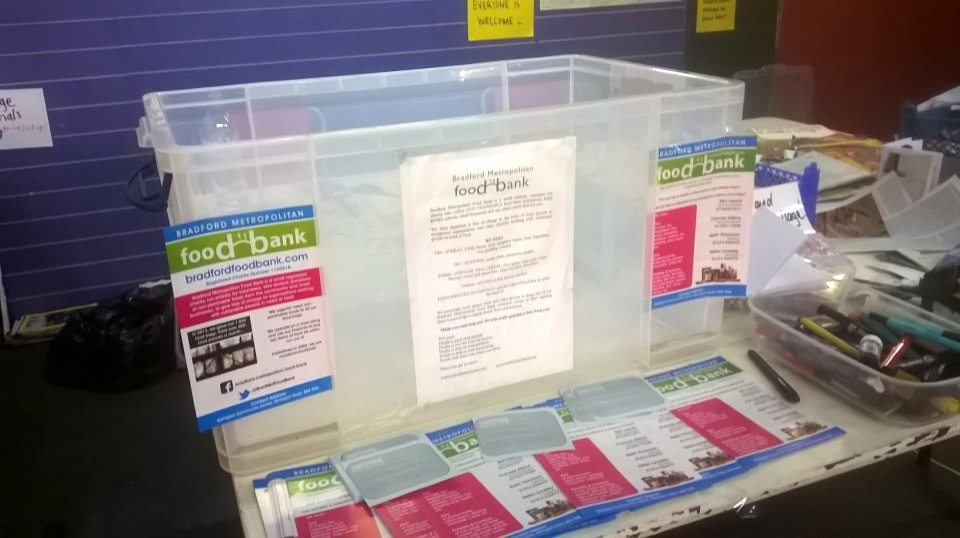
Food
donations box for Bradford Metropolitan foodbank. They need all the
help they can get, so please bring a donation if you can
What a great week it has been – thank you to everyone who has come down to make stuff and come in to talk. Looking forward to the next one!
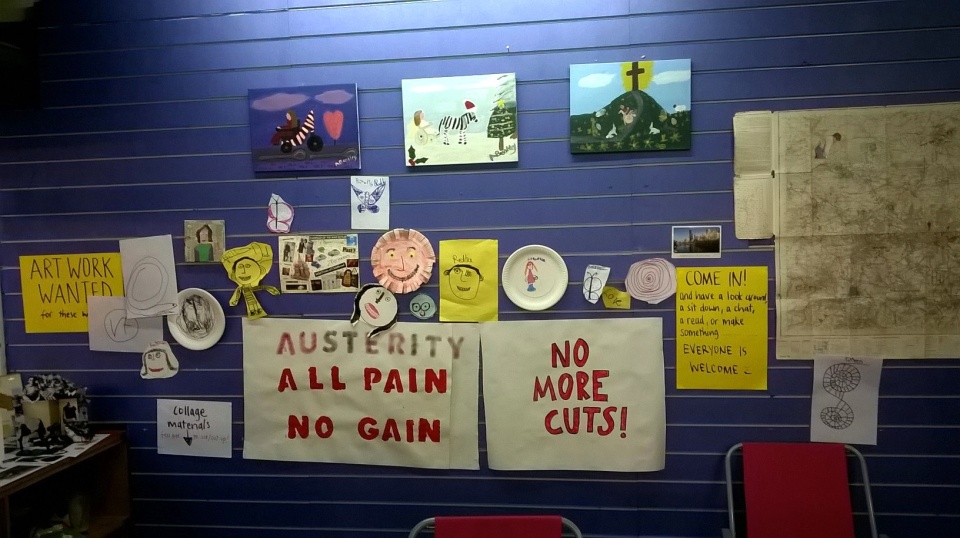
Tuesday, 26 May 2015
Marriage, Death and Tea.
"Come in for a coffee, then you can tell me all about your art. What's your medium?"
It took me a matter of hours to remember having a game plan was ridiculous. Of course it's natural to want to feel prepared, especially when someone has chosen to invest their time and cash in you, but, really, I should have known better. The people I meet, place I'm in and things that crop up are always at the centre of any work I make and it's not possible to pre-empt or prescribe that. I also know I can't visit a place just once if I'm to make real work there. I should have stopped the formulating, shoved some socks in a bag and just got myself here.
I'm 120 miles from home in Peterborough; the city where 'picking, packing and plucking' make the world go round. As the fastest growing UK city, Peterborough's historically central, agricultural industry is moving away in geography but not importance. I've never met so many people involved in working farms, co-operative food growing initiatives or groups advocating sustainable living. I've also seen a lot of people tucking in to crisps for breakfast, but you've got to maintain the balance somehow.
I've had two hosts in Peterborough: The Urban Engine Room and Sue's place. The Urban Engine Room is a very new space, built in the back garden of someone who saw a gap and didn't wait for someone else to fill it. Day to day, his children revise, watch films and hang out in there, but once a month or so it plays host to an artist. Sue was advertising her spare room, a twenty minute walk away, on Air BnB. I'd never been to Peterborough before and genuinely had no preconceptions of how it would be; everything about the week has been a surprise.
My work involves delicately unpicking a place, situation or topic. Often this leads into an event, but the people, conversations and skills that are uncovered and engaged are more important. I can see the process come together in a really physical way. It's as intricate as lace: A thread out of place, or a click in the pattern, and it's noticeable. Sometimes the key is to iron out the kinks, at other times it's embracing the inconsistencies and framing them in a way that helps them be viewed differently.
Once I had remembered to not worry about making 'things', I got on with saying 'Yes' to everything. Tea, coffee, beer, biscuits, curry, soup, sandwiches: A theme to the invitations emerged. In lots of ways, hospitality and food are synonymous, aren't they? Cooking and eating happens differently in every household, and depending on where in the world you are, but we all do it. It's a basic offer of care from a host and the ultimate window in for a guest. In that sense, I've been offered numerous windows into Peterborough.
A private gig in a musician's back garden.
Chats with artists commissioned to reconsider 'Harvest'.
A meeting with Peterborough's first ever high profile squatters.
Sharing theory, ethos and practice with a seasoned community developer.
An introduction to a co-operatively run green space, growing and teaching about plants and food.
Conversations with a disabled dancer about labels, funds and motivations.
Learning about and hand-picking a kilo of salad leaves in the middle of endless flat ground.
Having my feet washed in the local church.
Bending over maps and hearing about what was.
Noting every detail of recipes by my new favourite Lithuanian sandwich-maker.
Sharing a soda and lime with the performer who serenaded David Cameron with a ukulele.
A tour of Lincoln Road.
Cooking local ingredients to feed new friends.
Mapping in my first studio space.
I left Peterborough with an offer to go back in September. And again next year. And maybe even the year after that. No parachuting in: A sustained investment. For the many people who told me Peterborough is nothing special, this was a surprise.
I'd recommend a residency to anyone. Really: They should be a compulsory part of working in any any profession. Stepping out of your everyday is SO valuable. I came to know a new place through the people who live there; not tourist information. I had room to reflect on Leeds, where I live and work most of the time. I had space to map my thoughts in a way that really surprised me. I was freely given access to books, references and contexts that were new and exciting. I'm assured I was also able to reciprocate the incredible hospitality I received, open up conversation and kick off the imagining of other possibilities for Peterborough.
And, as my host just said in a text, "it's all just the start".
To carry on the conversation and see lots of photos from my residency, find me on on social media:
Twitter: @LydiaCatterall
Instagram: lydiacatterall
It took me a matter of hours to remember having a game plan was ridiculous. Of course it's natural to want to feel prepared, especially when someone has chosen to invest their time and cash in you, but, really, I should have known better. The people I meet, place I'm in and things that crop up are always at the centre of any work I make and it's not possible to pre-empt or prescribe that. I also know I can't visit a place just once if I'm to make real work there. I should have stopped the formulating, shoved some socks in a bag and just got myself here.
I'm 120 miles from home in Peterborough; the city where 'picking, packing and plucking' make the world go round. As the fastest growing UK city, Peterborough's historically central, agricultural industry is moving away in geography but not importance. I've never met so many people involved in working farms, co-operative food growing initiatives or groups advocating sustainable living. I've also seen a lot of people tucking in to crisps for breakfast, but you've got to maintain the balance somehow.
I've had two hosts in Peterborough: The Urban Engine Room and Sue's place. The Urban Engine Room is a very new space, built in the back garden of someone who saw a gap and didn't wait for someone else to fill it. Day to day, his children revise, watch films and hang out in there, but once a month or so it plays host to an artist. Sue was advertising her spare room, a twenty minute walk away, on Air BnB. I'd never been to Peterborough before and genuinely had no preconceptions of how it would be; everything about the week has been a surprise.
My work involves delicately unpicking a place, situation or topic. Often this leads into an event, but the people, conversations and skills that are uncovered and engaged are more important. I can see the process come together in a really physical way. It's as intricate as lace: A thread out of place, or a click in the pattern, and it's noticeable. Sometimes the key is to iron out the kinks, at other times it's embracing the inconsistencies and framing them in a way that helps them be viewed differently.
Once I had remembered to not worry about making 'things', I got on with saying 'Yes' to everything. Tea, coffee, beer, biscuits, curry, soup, sandwiches: A theme to the invitations emerged. In lots of ways, hospitality and food are synonymous, aren't they? Cooking and eating happens differently in every household, and depending on where in the world you are, but we all do it. It's a basic offer of care from a host and the ultimate window in for a guest. In that sense, I've been offered numerous windows into Peterborough.
A private gig in a musician's back garden.
Chats with artists commissioned to reconsider 'Harvest'.
A meeting with Peterborough's first ever high profile squatters.
Sharing theory, ethos and practice with a seasoned community developer.
An introduction to a co-operatively run green space, growing and teaching about plants and food.
Conversations with a disabled dancer about labels, funds and motivations.
Learning about and hand-picking a kilo of salad leaves in the middle of endless flat ground.
Having my feet washed in the local church.
Bending over maps and hearing about what was.
Noting every detail of recipes by my new favourite Lithuanian sandwich-maker.
Sharing a soda and lime with the performer who serenaded David Cameron with a ukulele.
A tour of Lincoln Road.
Cooking local ingredients to feed new friends.
Mapping in my first studio space.
I left Peterborough with an offer to go back in September. And again next year. And maybe even the year after that. No parachuting in: A sustained investment. For the many people who told me Peterborough is nothing special, this was a surprise.
I'd recommend a residency to anyone. Really: They should be a compulsory part of working in any any profession. Stepping out of your everyday is SO valuable. I came to know a new place through the people who live there; not tourist information. I had room to reflect on Leeds, where I live and work most of the time. I had space to map my thoughts in a way that really surprised me. I was freely given access to books, references and contexts that were new and exciting. I'm assured I was also able to reciprocate the incredible hospitality I received, open up conversation and kick off the imagining of other possibilities for Peterborough.
And, as my host just said in a text, "it's all just the start".
To carry on the conversation and see lots of photos from my residency, find me on on social media:
Twitter: @LydiaCatterall
Instagram: lydiacatterall
Friday, 15 May 2015
People Make Theatre: The role of the arts in the new politics
Great blog post by Jonathan Petherbridge that we just needed to share with our followers!
Jonathan issues a challenge to Arts Council England and arts institutions: Think about how art can be a process, an experience - not a product to be consumed.
We hope this reblog of Jonathan's post will stimulate further debate and, more importantly action - self-organising. The time is NOW!
ORIGINAL POST HERE:
People Make Theatre: The role of the arts in the new politics
It's the day after the full election result. Saturday. The radio and
papers are full of bemused reflection - how did the opinion polls get it
so wrong, where has liberalism gone, what direction should the Labour
Party now take, whither proportional representation ? Friends, family
and colleagues are slowly emerging from shocked despair and bracing
themselves for five more years.
But what's to do ?
Partly inspired by Stella Duffy's listing of her practical response and partly provoked by the fallout from Participation on Trial, I am wondering if the electoral outcome actually offers a challenge to the arts sector.
My fear is that the result of the election showed middle England's default position. People might flirt with Lib Dems but when the chips are down the tick goes to Conservatives - or possibly UKIP. I am trying to put myself in the position of a young first time voter not living in London or one of the cities like Leicester or Bristol that shunned the Tories. The serious conversations going on around this young me are about jobs and mortgages. My parents and teachers talk about interest rates and eradicating the national debt. I turn on the TV and any debate is framed almost entirely in the language of numbers and the context of money. In my area schools are becoming academies and seem to reinforce this default thinking. In the state schools too, arts subjects are becoming marginalised. And in the current climate my mates sort of think this is rational. Arts aren't going to get you a job - well not a proper job.
Is this the dominant thinking that young people are growing up receiving and believing ? Is it therefore becoming normal - even cool - to vote for a party that puts the individual before the society ? The shareholder before the customer. The self before others.
I think we should assume that these are now the default values of middle England. Beyond London apart from a few northern outposts and a scattering of island-cities surrounded by a sea of blue voters, for the majority the dominant values are the values of the market.
So what's to do ?
A coherent political response is going to take some time to formulate and I fear it's going to get worse before it gets better. But while we're waiting for the party wheels to grind I think the arts, especially participatory arts, can offer a surprisingly different way of looking at things.
Arts activities offer young (and old) people a space where things are valued differently. In the best cases they offer a space where we value ourselves and each other differently. Countless arts projects involve people in playing, making, writing and performing, and these operate through a different set of values. Most encourage co-operation, accessibility, listening, respect. Many build work from individual personal narratives, but artfully amplify these with the contributions of many. A recent piece at the Young Vic was woven from the testimonies of female carers over several months*. I was fortunate to catch one of the performances given by a cast of about 30 female carers. The sense of solidarity was tangible. The exploration and celebration of an abstract concept ('care') had the audience doing that smiling/glowing thing. And the dancing was fantastic. The values on show, and I suspect throughout the process offered an alternative argument of what is important in life, and - and this is key - that argument was registered emotionally and physically.
In many instances art is increasingly regarded as a commodity rather than a means of self and/or group expression. Even in participatory arts there seems to be a greater emphasis on the product rather than the process and I am seeing a growing tendency to think about the market and the wrapping of the goods for sale, right from the off ? Sometimes our responses themselves are monetised - if a viewer or participant values art for what it does to their mood or mind, spirit or soul, then that response may well appear on the billboard or in the funding bid for the next endeavour.
I think many of us are falling into this money and numbers game - it's not surprising. The number one coffee break conversation at any conference is going to be funding. The number one piece of work will be a spreadsheet. The first demand from a funder will be outputs - or outcomes measured numerically. And artists continue to talk about how they are paid (or aren't paid) - publicly.
But we must hold our nerve. The default political position described above leaves a vacuum. I like to think (and this may be very old fashioned) that people require other things. Friendship, connection, love, humour - soft and squidgy sort of spiritual things that make it worth getting up in the morning. Things that some link to the concept of Wellbeing. The arts - especially participatory arts - offers space where people can experience this - other places do too, faith groups and sports clubs, the WI and the allotment. But participatory arts spaces have less of an agenda and are more explicit about stating the rules of engagement - the ethos. Skilled facilitators - be they a conductor or youth theatre leader will mediate a space where teamwork is all, they will foster and monitor a atmosphere of connection and creativity. And the dancing will be fantastic (and it will include seated dancing too).
While society sorts out how it wants to be represented politically, I think it is important that the arts offers opportunities for people to meet and work positively together. Non-religious, non-institutional, open and accessible spaces where an alternative set of values can be experienced. I challenge the Arts sector - the Arts Council and the 'institutions' to consider how they can present art not as a product, but as a process, to be experienced - not consumed.
* https://youngviclondon.wordpress.com/2015/05/12/turning-a-little-further-two-boroughs-at-the-young-vic/
Jonathan issues a challenge to Arts Council England and arts institutions: Think about how art can be a process, an experience - not a product to be consumed.
We hope this reblog of Jonathan's post will stimulate further debate and, more importantly action - self-organising. The time is NOW!
ORIGINAL POST HERE:
People Make Theatre: The role of the arts in the new politics
The role of the arts in the new politics
But what's to do ?
Partly inspired by Stella Duffy's listing of her practical response and partly provoked by the fallout from Participation on Trial, I am wondering if the electoral outcome actually offers a challenge to the arts sector.
My fear is that the result of the election showed middle England's default position. People might flirt with Lib Dems but when the chips are down the tick goes to Conservatives - or possibly UKIP. I am trying to put myself in the position of a young first time voter not living in London or one of the cities like Leicester or Bristol that shunned the Tories. The serious conversations going on around this young me are about jobs and mortgages. My parents and teachers talk about interest rates and eradicating the national debt. I turn on the TV and any debate is framed almost entirely in the language of numbers and the context of money. In my area schools are becoming academies and seem to reinforce this default thinking. In the state schools too, arts subjects are becoming marginalised. And in the current climate my mates sort of think this is rational. Arts aren't going to get you a job - well not a proper job.
Is this the dominant thinking that young people are growing up receiving and believing ? Is it therefore becoming normal - even cool - to vote for a party that puts the individual before the society ? The shareholder before the customer. The self before others.
I think we should assume that these are now the default values of middle England. Beyond London apart from a few northern outposts and a scattering of island-cities surrounded by a sea of blue voters, for the majority the dominant values are the values of the market.
So what's to do ?
A coherent political response is going to take some time to formulate and I fear it's going to get worse before it gets better. But while we're waiting for the party wheels to grind I think the arts, especially participatory arts, can offer a surprisingly different way of looking at things.
Arts activities offer young (and old) people a space where things are valued differently. In the best cases they offer a space where we value ourselves and each other differently. Countless arts projects involve people in playing, making, writing and performing, and these operate through a different set of values. Most encourage co-operation, accessibility, listening, respect. Many build work from individual personal narratives, but artfully amplify these with the contributions of many. A recent piece at the Young Vic was woven from the testimonies of female carers over several months*. I was fortunate to catch one of the performances given by a cast of about 30 female carers. The sense of solidarity was tangible. The exploration and celebration of an abstract concept ('care') had the audience doing that smiling/glowing thing. And the dancing was fantastic. The values on show, and I suspect throughout the process offered an alternative argument of what is important in life, and - and this is key - that argument was registered emotionally and physically.
In many instances art is increasingly regarded as a commodity rather than a means of self and/or group expression. Even in participatory arts there seems to be a greater emphasis on the product rather than the process and I am seeing a growing tendency to think about the market and the wrapping of the goods for sale, right from the off ? Sometimes our responses themselves are monetised - if a viewer or participant values art for what it does to their mood or mind, spirit or soul, then that response may well appear on the billboard or in the funding bid for the next endeavour.
I think many of us are falling into this money and numbers game - it's not surprising. The number one coffee break conversation at any conference is going to be funding. The number one piece of work will be a spreadsheet. The first demand from a funder will be outputs - or outcomes measured numerically. And artists continue to talk about how they are paid (or aren't paid) - publicly.
But we must hold our nerve. The default political position described above leaves a vacuum. I like to think (and this may be very old fashioned) that people require other things. Friendship, connection, love, humour - soft and squidgy sort of spiritual things that make it worth getting up in the morning. Things that some link to the concept of Wellbeing. The arts - especially participatory arts - offers space where people can experience this - other places do too, faith groups and sports clubs, the WI and the allotment. But participatory arts spaces have less of an agenda and are more explicit about stating the rules of engagement - the ethos. Skilled facilitators - be they a conductor or youth theatre leader will mediate a space where teamwork is all, they will foster and monitor a atmosphere of connection and creativity. And the dancing will be fantastic (and it will include seated dancing too).
While society sorts out how it wants to be represented politically, I think it is important that the arts offers opportunities for people to meet and work positively together. Non-religious, non-institutional, open and accessible spaces where an alternative set of values can be experienced. I challenge the Arts sector - the Arts Council and the 'institutions' to consider how they can present art not as a product, but as a process, to be experienced - not consumed.
* https://youngviclondon.wordpress.com/2015/05/12/turning-a-little-further-two-boroughs-at-the-young-vic/
Tuesday, 27 January 2015
'Three Years/Three Years' by Anthony Schrag...
This is a reblog of a post by participatory artist Anthony Schrag that's incredibly important to our notions of defining our field(s) of practice(s) not as 'a community of one voice' but an alliance of multiple voices. Many of us share Anthony's frustrations about professionalisation and attempts to impose a false hegemony on socially engaged/ participatory arts...
Serendipity or coincidence meant that the three years of my PhD coincided with the three years of the Artworks Pathfinder projects, and, being in Scotland, I have attended all three Scottish conferences. I grew with them and, like youthful playmates who find themselves staring into a unknown future abyss together, I find myself at a personal and professional juncture, similar, perhaps to the state of the Artworks project finds itself now. As I am now also in the stages of wrapping up my research into notions of participation, I too feel the looming ‘what next?’ question sidle up to me at vulnerable moments.
Even though I occupy a position external to Artworks Scotland, over the past three years I felt very welcomed into the discourse it espoused, and that sense of inclusivity has been gratefully accepted. Over time, I’ve also noticed my own shift from a novice outsider with high hopes, to an invited angry provocateur, to a jaded dissenter, hopelessly clinging on to notions that things will change. I now find myself wondering how the Artworks project has influenced me and I have influenced it, and how my future will be different once I finish my research: will that future have been altered because of Artworks? What do I do with my own inquiry into participation, now that formal structure of support is ending? Do the questions that we asked just fade away? How can it have meaning? And, as the conference drew to close yesterday and we were left ruminating on a professional ‘what next?’ I had my own thoughts about the day – and the future.
Cynics and Sing-a-longs: The choice to include mostly theatre/music folks in the presentations is probably an apt representation of the populations involved in ‘participatory works.’ However, more numbers do not necessarily equal a unified whole: such is the problem with ‘democracy’ – the loudest and largest get to speak for the lesser few. This does not bode well for a ‘community of practice’. David Camlin’s Dialogical Sing-a-long went down a storm for some, but for myself and an embarrassed few (mostly visual artists, it must be said) we sat cringing at our tables, rolling our eyes at such ‘kumbaya’ tactics. Its funny to consider now, but it reveals a deeper dissonance that has still yet been unpicked: the difference in intentions and methodologies that do not link us. Yes, we are, as Susanne Burns suggested in her closing speech, all linked by matters of ‘collaboration’ but the focus on our similarities at the cost of our differences is highly problematic. It would be equivalent to reducing doctors down to ‘those interested in hygiene’, or physicists to ‘those that use mathematics’. That we are linked purely by ‘collaboration’ is possibly too simplistic. Yes, we do all collaborate, its true: but things also draw us apart, and it is this difference – this ‘how are we unlike each other’ that never seems to be given enough attention. This becomes problematic if we’re being presented as a unified whole of ‘participatory practitioners’.
Internals and Externals: Too often in these sorts of conferences, we rely on those we know and the conversation becomes a bit incestuously deformed. Should the conference co-ordinator also be speaking about her research? I personally think not: it warps the findings to be quite limited. Often, we stay in this narrow band because it is easiest when planning, but if indeed the project is about the breadth of participation, I wonder to what extent the research is skewed because we have invited the right kind of people to attend. That ‘right’ kind of people aligns with ‘open-space’ seminars, but the issue with those is that it becomes justification for a narrow focus; for not doing the hard work of getting the wrong sort of people involved. What of those artists who could not attend because they couldn’t afford the entry fee; those participants who had to go to work; those dissenters who had awful experiences with participatory artists; those gallery administration staff who had to stay and open the buildings? The grist and meat of participation comes in the minutia of projects, and the same is true for research: what have we missed by not seeking out other voices? Are we patting ourselves on the back while ignoring those outside the room?
Language and Voice: I am amazed, after 3 years, that we are still no where nearer to defining what we mean by ‘participation’. 60% of me thinks this is a good thing. I would hate to reduce the diversity of practice into narrow headings and definitions. The other 40% gets filled with a vibratory rage that we use a single word to talk about many very, very different things, with very different intentions and desired outcomes. Is it correct to elide applied participatory works that hope to change and benefit communities with the transgressive, abusive-like works of Santiago Sierra, for example? If I believe it is ethically problematic to assume that participatory projects should ‘help’ other people, should I be thrown-together who feels their work should have an ameliorative impact? Education and participation are still confounded, despite meaning – and intending – very different things; No distinction is made on those that undertake ‘participation’ as paid work to supplement their practice, and those whose entire artistic career is participatory; there remains no challenge to the professionalisation of an industry vs the call for artists to be professional.
This latter, perhaps is the biggest hurdle for me: is there a difference between a professional participatory artist and a professional artist? Creative Scotland has released a report that grew from the Artworks project titled: Developing a Foundation for Quality Guidance for arts organisations and artists in Scotland working in participatory settings. Does, I wonder, Painting have a Foundation for Quality Guidance? Or Sculpture? Or Video art? In what ways are we hemming ourselves in with this professionalisation? In conferences, this lack of a specific definition is perhaps quite useful, because we can be dialogic about meanings: we can argue and unravel what we mean and discover our differences. We can speak to each other. The problem is comes when these conferences lead to reports: reports that are not able to unravel this diversity of meaning and intention because their purpose is to distill meaning down into bite-sized mouthfuls. These reports – especially because the practice is so new and many do not know much about it – are often then are taken as fact: the research is taken as the be-all-and-end-all of information into participatory settings. They will, no doubt, be implemented as policy.
And this when the ‘what next?’ becomes frightening. Because, if I do not fit into the categories of the assumed notion of participation, do I cease to exist as a participatory artist? What if I have a different notion of quality then the framework of the report? Am I then a bad participatory practitioner? If the written documents are not clear about this lack of a cohesive and shared notion of quality; of the diversity of practice; of differing ethical frameworks; of the multiplicity of intentions; of the plethora of desires we all have in ‘working with people’ then they are bound to exclude. If we are indeed trying to come together in a “community of one voice” how can we build it into a continuum that really can accommodate the gamut of practices?
For my part, I think this must come in a recognition – in written language – that the practice is not fixable into one thing: I know this is often said, but it is not expressed nor truly communicated. It is not explicitly shown in the conferences and reports that it is a practice which incorporates those that wish to help and those that wish to transgress; those who desire a political imperative and those that want to entertain; those that want to align themselves to social work and those that find such a proposition patronising and ethically problematic; those that merely undertake participatory projects as it supplements their non-collaborative practice, and those whose very ethos is a co-authorial approach. We cannot be lazy and hope that these differences are implicit and understood. They are not. This is evidenced by the very discussions we are still having – after 3 years – about what it all means to work with people. If we, as a community of one voice, cannot collectively agree on this continuum of practice, how can we ever assume others will understand?
Serendipity or coincidence meant that the three years of my PhD coincided with the three years of the Artworks Pathfinder projects, and, being in Scotland, I have attended all three Scottish conferences. I grew with them and, like youthful playmates who find themselves staring into a unknown future abyss together, I find myself at a personal and professional juncture, similar, perhaps to the state of the Artworks project finds itself now. As I am now also in the stages of wrapping up my research into notions of participation, I too feel the looming ‘what next?’ question sidle up to me at vulnerable moments.
Even though I occupy a position external to Artworks Scotland, over the past three years I felt very welcomed into the discourse it espoused, and that sense of inclusivity has been gratefully accepted. Over time, I’ve also noticed my own shift from a novice outsider with high hopes, to an invited angry provocateur, to a jaded dissenter, hopelessly clinging on to notions that things will change. I now find myself wondering how the Artworks project has influenced me and I have influenced it, and how my future will be different once I finish my research: will that future have been altered because of Artworks? What do I do with my own inquiry into participation, now that formal structure of support is ending? Do the questions that we asked just fade away? How can it have meaning? And, as the conference drew to close yesterday and we were left ruminating on a professional ‘what next?’ I had my own thoughts about the day – and the future.
Cynics and Sing-a-longs: The choice to include mostly theatre/music folks in the presentations is probably an apt representation of the populations involved in ‘participatory works.’ However, more numbers do not necessarily equal a unified whole: such is the problem with ‘democracy’ – the loudest and largest get to speak for the lesser few. This does not bode well for a ‘community of practice’. David Camlin’s Dialogical Sing-a-long went down a storm for some, but for myself and an embarrassed few (mostly visual artists, it must be said) we sat cringing at our tables, rolling our eyes at such ‘kumbaya’ tactics. Its funny to consider now, but it reveals a deeper dissonance that has still yet been unpicked: the difference in intentions and methodologies that do not link us. Yes, we are, as Susanne Burns suggested in her closing speech, all linked by matters of ‘collaboration’ but the focus on our similarities at the cost of our differences is highly problematic. It would be equivalent to reducing doctors down to ‘those interested in hygiene’, or physicists to ‘those that use mathematics’. That we are linked purely by ‘collaboration’ is possibly too simplistic. Yes, we do all collaborate, its true: but things also draw us apart, and it is this difference – this ‘how are we unlike each other’ that never seems to be given enough attention. This becomes problematic if we’re being presented as a unified whole of ‘participatory practitioners’.
Internals and Externals: Too often in these sorts of conferences, we rely on those we know and the conversation becomes a bit incestuously deformed. Should the conference co-ordinator also be speaking about her research? I personally think not: it warps the findings to be quite limited. Often, we stay in this narrow band because it is easiest when planning, but if indeed the project is about the breadth of participation, I wonder to what extent the research is skewed because we have invited the right kind of people to attend. That ‘right’ kind of people aligns with ‘open-space’ seminars, but the issue with those is that it becomes justification for a narrow focus; for not doing the hard work of getting the wrong sort of people involved. What of those artists who could not attend because they couldn’t afford the entry fee; those participants who had to go to work; those dissenters who had awful experiences with participatory artists; those gallery administration staff who had to stay and open the buildings? The grist and meat of participation comes in the minutia of projects, and the same is true for research: what have we missed by not seeking out other voices? Are we patting ourselves on the back while ignoring those outside the room?
Language and Voice: I am amazed, after 3 years, that we are still no where nearer to defining what we mean by ‘participation’. 60% of me thinks this is a good thing. I would hate to reduce the diversity of practice into narrow headings and definitions. The other 40% gets filled with a vibratory rage that we use a single word to talk about many very, very different things, with very different intentions and desired outcomes. Is it correct to elide applied participatory works that hope to change and benefit communities with the transgressive, abusive-like works of Santiago Sierra, for example? If I believe it is ethically problematic to assume that participatory projects should ‘help’ other people, should I be thrown-together who feels their work should have an ameliorative impact? Education and participation are still confounded, despite meaning – and intending – very different things; No distinction is made on those that undertake ‘participation’ as paid work to supplement their practice, and those whose entire artistic career is participatory; there remains no challenge to the professionalisation of an industry vs the call for artists to be professional.
This latter, perhaps is the biggest hurdle for me: is there a difference between a professional participatory artist and a professional artist? Creative Scotland has released a report that grew from the Artworks project titled: Developing a Foundation for Quality Guidance for arts organisations and artists in Scotland working in participatory settings. Does, I wonder, Painting have a Foundation for Quality Guidance? Or Sculpture? Or Video art? In what ways are we hemming ourselves in with this professionalisation? In conferences, this lack of a specific definition is perhaps quite useful, because we can be dialogic about meanings: we can argue and unravel what we mean and discover our differences. We can speak to each other. The problem is comes when these conferences lead to reports: reports that are not able to unravel this diversity of meaning and intention because their purpose is to distill meaning down into bite-sized mouthfuls. These reports – especially because the practice is so new and many do not know much about it – are often then are taken as fact: the research is taken as the be-all-and-end-all of information into participatory settings. They will, no doubt, be implemented as policy.
And this when the ‘what next?’ becomes frightening. Because, if I do not fit into the categories of the assumed notion of participation, do I cease to exist as a participatory artist? What if I have a different notion of quality then the framework of the report? Am I then a bad participatory practitioner? If the written documents are not clear about this lack of a cohesive and shared notion of quality; of the diversity of practice; of differing ethical frameworks; of the multiplicity of intentions; of the plethora of desires we all have in ‘working with people’ then they are bound to exclude. If we are indeed trying to come together in a “community of one voice” how can we build it into a continuum that really can accommodate the gamut of practices?
For my part, I think this must come in a recognition – in written language – that the practice is not fixable into one thing: I know this is often said, but it is not expressed nor truly communicated. It is not explicitly shown in the conferences and reports that it is a practice which incorporates those that wish to help and those that wish to transgress; those who desire a political imperative and those that want to entertain; those that want to align themselves to social work and those that find such a proposition patronising and ethically problematic; those that merely undertake participatory projects as it supplements their non-collaborative practice, and those whose very ethos is a co-authorial approach. We cannot be lazy and hope that these differences are implicit and understood. They are not. This is evidenced by the very discussions we are still having – after 3 years – about what it all means to work with people. If we, as a community of one voice, cannot collectively agree on this continuum of practice, how can we ever assume others will understand?
Saturday, 24 January 2015
Submit your new or existing blog posts, essays, etc. for publication on our blog
We're asking anyone who would like to share their thoughts new or old about socially engaged, ecologically engaged, participatory or activist arts with us so we can, in turn, (re)publish them here to stimulate open debate.
The posts can be about your practice, thoughts about the field, politics of our practice, academic research... anything you feel is relevant!
Please email us docs or links at engagedartnet@googlegroups.com and we'll publish quickly...
Look forward to hearing from you!
Subscribe to:
Posts (Atom)

